Validation of a Contrail Life-Cycle Model in Central Europe
Abstract
:1. Introduction
2. Methodology
2.1. Ground-Based Photographic Contrail Detection
2.2. Aircraft/Flight Identification and ADS-B Data Extraction
2.3. Weather-Data Sources
2.3.1. Aircraft Meteorological Data Relay (AMDAR)
2.3.2. Radiosonde Humidity Measurements
2.3.3. Modelled Weather Data
2.4. Aircraft Performance Model
3. Contrail Life Cycle
3.1. Dissipation Regime
3.2. Diffusion Regime
Contrail Drift
4. Results
4.1. Observed and Identified Aircraft with Contrail Formation
4.2. Single-Flight Analysis
4.3. Comparison with Other Studies
5. Conclusions and Outlook
Author Contributions
Funding
Data Availability Statement
Acknowledgments
Conflicts of Interest
References
- Lee, D.S.; Pitari, G.; Grewe, V.; Gierens, K.; Penner, J.E.; Petzold, A.; Prather, M.J.; Schumann, U.; Bais, A.; Berntsen, T.; et al. Transport impacts on atmosphere and climate: Aviation. Atmos. Environ. 2010, 44, 4678–4734. [Google Scholar] [CrossRef] [PubMed]
- Lee, D.; Fahey, D.; Skowron, A.; Allen, M.; Burkhardt, U.; Chen, Q.; Doherty, S.; Freeman, S.; Forster, P.; Fuglestvedt, J.; et al. The contribution of global aviation to anthropogenic climate forcing for 2000 to 2018. Atmos. Environ. 2021, 244, 117834. [Google Scholar] [CrossRef] [PubMed]
- Burkhardt, U.; Kärcher, B.; Mannstein, H.; Schumann, U. Climate impact of contrails and contrail cirrus. In Subject Specific White Paper IV, Aviation Climate Change Research Initiative (ACCRI); United States Department of Transportation, Federal Aviation Administration: Washington, DC, USA, 2008. [Google Scholar]
- Rosenow, J.; Chen, G.; Fricke, H.; Wang, Y. Factors Impacting Chinese and European Vertical Fight Efficiency. Aerospace 2022, 9, 76. [Google Scholar] [CrossRef]
- Gierens, K.; Vázquez-Navarro, M. Statistical analysis of contrail lifetimes from a satellite perspective. Meteorol. Z. 2018, 27, 183–193. [Google Scholar] [CrossRef]
- Rosenow, J. Optical Properties of Condenstation Trails. Ph.D. Thesis, Technische Universität Dresden, Dresden, Germany, 2016. [Google Scholar]
- Vázquez-Navarro, M.; Mannstein, H.; Mayer, B. An automatic contrail tracking algorithm. Atmos. Meas. Tech. 2010, 3, 1089–1101. [Google Scholar] [CrossRef]
- Mannstein, H.; Vázquez-Navarro, M.; Graf, K.; Duda, D.; Schumann, U. Contrail Detection in Satellite Images. In Atmospheric Physics: Background—Methods—Trends; Springer: New York, NY, USA, 2012; p. 433. [Google Scholar]
- Zhang, G.; Zhang, J.; Shang, J. Contrail Recognition with Convolutional Neural Network and Contrail Parameterizations Evaluation. SOLA 2018, 14, 132–137. [Google Scholar] [CrossRef]
- Duda, D.P.; Bedka, S.T.; Minnis, P.; Spangenberg, D.; Khlopenkov, K.; Chee, T.; Smith, W.L., Jr. Northern Hemisphere contrail properties derived from Terra and Aqua MODIS data for 2006 and 2012. Atmos. Chem. Phys. 2019, 19, 5313–5330. [Google Scholar] [CrossRef]
- McCloskey, K.; Geraedts, S.; Van Arsdale, C.; Brand, E. A human-labeled Landsat-8 contrails dataset. In Proceedings of the ICML 2021 Workshop on Tackling Climate Change with Machine Learning, Virtually, 23 July 2021. [Google Scholar]
- Meijer, V.R.; Kulik, L.; Eastham, S.D.; Allroggen, F.; Speth, R.L.; Karaman, S.; Barrett, S.R.H. Contrail coverage over the United States before and during the COVID-19 pandemic. Environ. Res. Lett. 2022, 17, 034039. [Google Scholar] [CrossRef]
- Wang, Z.; Bugliaro, L.; Jurkat-Witschas, T.; Heller, R.; Burkhardt, U.; Ziereis, H.; Dekoutsidis, G.; Wirth, M.; Groß, S.; Kirschler, S.; et al. Observations of microphysical properties and radiative effects of contrail cirrus and natural cirrus over the North Atlantic. Atmos. Chem. Phys. Discuss. 2022, 2022, 1–36. [Google Scholar] [CrossRef]
- Schumann, U. A contrail cirrus prediction tool. In Proceedings of the International Conferences on Transport, Atmosphere and Climate, DLR/EUR, Aachen and Maastricht, Prien am Chiemsee, Germany, 22–25 June 2009. [Google Scholar]
- Schumann, U.; Heymsfield, A. On the lifecycle of individual contrails and contrail cirrus. AMS Meteorol. Monogr. 2017, 58, 3.1–3.24. [Google Scholar]
- Jones, H.M.; Haywood, J.; Marenco, F.; O’Sullivan, D.; Meyer, J.; Thorpe, R.; Gallagher, M.W.; Krämer, M.; Bower, K.N.; Rädel, G.; et al. A methodology for in-situ and remote sensing of microphysical and radiative properties of contrails as they evolve into cirrus. Atmos. Chem. Phys. 2012, 12, 8157–8175. [Google Scholar] [CrossRef]
- Spinhirne, J.; Hart, W.; Duda, D. Evolution of the morphology and microphysics of contrail cirrus from airborne remote sensing. Geophys. Res. Lett. 1998, 25, 1153–1156. [Google Scholar] [CrossRef]
- Rap, A.; Forster, P.M.; Haywood, J.M.; Jones, A.; Boucher, O. Estimating the climate impact of linear contrails using the UK Met Office climate model. Geophys. Res. Lett. 2010, 37, 1–6. [Google Scholar] [CrossRef]
- Schmidt, E. Die Entstehung von Eisnebel aus den Auspuffgasen von Flugmotoren. Schriften Dtsch. Akad. Luftfahrtforsch. Verl. Oldenbourg MÜNchen/Berlin 1941, 44, 1–15. [Google Scholar]
- Sussmann, R.; Gierens, K.M. Lidar and numerical studies on the different evolution of vortex pair and secondary wake in young contrails. J. Geophys. Res. 1999, 104, 2131–2142. [Google Scholar] [CrossRef]
- Lán, S.; Hospodka, J. Contrail Lifetime in Context of Used Flight Levels. Sustainability 2022, 14, 5877. [Google Scholar] [CrossRef]
- Hoff, A.M. Humidity Measurements by Aircraft of the E-AMDAR Fleet; Observing Networks and Data: Offenbach am Main, Germany, 2008. [Google Scholar]
- World Meteorological Organization. Aircraft Meteorological Data Relay (AMDAR) Reference Manual; WMO No. 958; Secretariat of the World Meteorological Organization: Geneva, Switzerland, 2003. [Google Scholar]
- Rosenow, J.; Lindner, M.; Scheiderer, J. Advanced Flight Planning and the Benefit of In-Flight Aircraft Trajectory Optimization. Sustainability 2021, 13, 1383. [Google Scholar] [CrossRef]
- Zhang, Y.; Sun, K.; Gao, Z.; Pan, Z.; Shook, M.; Li, D. Diurnal Climatology of Planetary Boundary Layer Height Over the Contiguous United States Derived From AMDAR and Reanalysis Data. J. Geophys. Res. Atmos. 2020, 125, e2020JD032803. [Google Scholar] [CrossRef]
- NOAA/Earth System Research Laboratory (ESRL). Aircraft Meteorological Data Reports (AMDAR) and Aircraft Communications Addressing and Reporting System (ACARS) Data; Version 1.0; UCAR/NCAR—Earth Observing Laboratory: Boulder, CO, USA, 2023. [Google Scholar]
- Hoff, A.; Smit, H.; Taylor, S.; Carlberg, S.; Berechree, M. Advancements in the AMDAR Humidity Sensing 2023. In Proceedings of the WMO Technical Conference on Meteorological and Environmental Instruments and Methods of Observation (TECO-2010), Helsinki, Finland, 30 August–1 September 2010. [Google Scholar]
- Petzold, A.; Thouret, V.; Gerbig, C.; Zahn, A.; Brenninkmeijer, C.; Gallagher, M.; Hermann, M.; Pontaud, M.; Ziereis, H.; Boulanger, D.; et al. Global-scale atmosphere monitoring by in-service aircraft—Current achievements and future prospects of the European Research Infrastructure IAGOS. Tellus B 2015, 67, 28452. [Google Scholar] [CrossRef]
- Reutter, P.; Neis, P.; Rohs, S.; Sauvage, B. Ice supersaturated regions: Properties and validation of ERA-Interim reanalysis with IAGOS in situ water vapour measurements. Atmos. Chem. Phys. 2020, 20, 787–804. [Google Scholar] [CrossRef]
- Oolman, L. University of Wyoming, Atmospheric Soundings. 2023. Available online: https://weather.uwyo.edu/upperair/sounding.html (accessed on 2 May 2023).
- Govett, M. NOAA/ESRL Radiosonde Database; Global Systems Laboratory: Boulder, CO, USA, 2023. [Google Scholar]
- Vaisala Radiosonde RS41-SG; Datasheet. 2017. Available online: https://www.vaisala.com/sites/default/files/documents/WEA-MET-RS41-Datasheet-B211321EN.pdf (accessed on 2 May 2023).
- National Oceanic and Atmospheric Administration. Global Data Assimilation System (GDAS), Technical Report. 2016. Available online: http://ready.arl.noaa.gov/gdas1.php (accessed on 2 May 2023).
- Lindner, M.; Rosenow, J.; Zeh, T.; Fricke, H. In-Flight Aircraft Trajectory Optimization within Corridors Defined by Ensemble Weather Forecasts. Aerospace 2020, 7, 144. [Google Scholar] [CrossRef]
- Förster, S.; Rosenow, J.; Lindner, M.; Fricke, H. A Toolchain for Optimizing Trajectories under real Weather Conditions and Realistic Flight Performance. In Proceedings of the Greener Aviation, Brussels, Belgium, 11–13 October 2016. [Google Scholar]
- Rosenow, J.; Zeh, T.; Lindner, M.; Förster, S.; Fricke, H.; Caraud, A. Multiple Aircraft in a multi-criteria Trajectory Optimization. In Proceedings of the Fifteenth USA/Europe Air Traffic Management Research and Development Seminar (ATM2023), Savannah, GA, USA, 5–9 June 2023. [Google Scholar]
- Brent, R.P. An algorithm with guaranteed convergence for finding a zero of a function. Comput. J. 1971, 14, 422–425. [Google Scholar] [CrossRef]
- Sun, J.; Hoekstra, J.M.; Ellerbroek, J. OpenAP: An Open-Source Aircraft Performance Model for Air Transportation Studies and Simulations. Aerospace 2020, 7, 104. [Google Scholar] [CrossRef]
- Rosenow, J.; Förster, S.; Lindner, M.; Fricke, H. Multi-objective trajectory optimization. In International Transportation; Special Edition 1; Trialog Publishers Verlagsgesellschaft: Baiersbronn, Germany, 2016. [Google Scholar]
- Sonntag, D. Advancements in Field Hygrometry, Review Article. Meteorol. Z. 1994, 3, 51–66. [Google Scholar] [CrossRef]
- Schumann, U. On conditions for Contrail formation from aircraft exhaust. Meteorol. Z. 1996, 5, 4–23. [Google Scholar] [CrossRef]
- Paugam, R.; Paoli, R.; Cariolle, D. Influence of vortex dynamics and atmospheric turbulence on the early evolution of a contrail. Atmos. Chem. Phys. 2010, 10, 3933–3952. [Google Scholar] [CrossRef]
- Holzäpfel, F. Probabilistic Two-Phase Wake Vortex Decay and Transport Model. J. Aircr. 2003, 40, 323–331. [Google Scholar] [CrossRef]
- Foken, T. Angewandte Meteorologie; Springer: Berlin/Heidelberg, Germany, 2006. [Google Scholar]
- Sharman, R.D.; Cornman, L.B.; Meymaris, G.; Pearson, J. Description and Derived Climatologies of Automated In Situ Eddy-Dissipation-Rate Reports of Atmospheric Turbulence. J. Appl. Meteorol. Climatol. 2014, 53, 1416–1432. [Google Scholar] [CrossRef]
- Sharman, R.D.; Pearson, J.M. Prediction of Energy Dissipation Rates for Aviation Turbulence. Part I: Forecasting Nonconvective Turbulence. J. Appl. Meteorol. Climatol. 2017, 56, 317–337. [Google Scholar] [CrossRef]
- Etling, D. Theoretische Meteorologie; Springer: Berlin/Heidelberg, Germany, 2008. [Google Scholar]
- Betz, A. Verhalten von Wirbelsystemen. Z. Für Angew. Math. Und Mech. 1932, 12, 164–174. [Google Scholar] [CrossRef]
- Glauert, H. Die Grundlagen der Tragflügel- und Luftschraubentheorie, 1st ed.; Softcover Reprint of the Original 1929 ed.; Springer: New York, NY, USA, 2013. [Google Scholar]
- Sussmann, R.; Gierens, K.M. Differences in early contrail evolution of two-engine versus four-engine aircraft: Lidar measurements and numerical simulations. J. Geophys. Res. 2001, 106, 4899–4911. [Google Scholar] [CrossRef]
- Anderson, J.D. Introduction to Flight; McGraw-Hill: New York, NY, USA, 1989. [Google Scholar]
- Sarpkaya, T. A new model for vortex decay in the atmosphere. J. Aircr. 2000, 37, 53–61. [Google Scholar] [CrossRef]
- Burnham, D.C.; Hallock, J.N. Chicago Monostatic Acoustic Vortex Sensor System; Report No. DOT-TSC-FAA-79-103.IV; Federal Aviation Administration (FAA): Washington, DC, USA, 1982. [Google Scholar]
- Holzäpfel, F.; Gerz, T.; Baumann, R. The turbulent decay of trailing vortex pairs in stably stratified environments. Aerosp. Sci. Technol. 2001, 5, 95–108. [Google Scholar] [CrossRef]
- Schumann, U.; Konopka, P.; Baumann, R.; Busen, R.; Gerz, T.; Schlager, D.; Schulte, P.; Volkert, H. Estimate of diffusion parameters of aircraft exhaust plumes near the tropopause from nitric oxide and turbulence measurements. J. Geophys. Res. 1995, 100, 14147–14162. [Google Scholar] [CrossRef]
- Merziger, G.; Mühlbach, G.; Wille, D.; Wirth, T. Formeln + Hilfen zur Höheren Mathematik; Binomi: Hannover, Germany, 2001. [Google Scholar]
- Rosenow, J.; Kaiser, M.; Fricke, H. Modeling Contrail life cycles based on highly precise flight profile data of modern aircraft. In Proceedings of the International Conference on Research in Airport Transportation (ICRAT), Berkeley, CA, USA, 22–25 May 2012. [Google Scholar]
- Rosenow, J.; Fricke, H. Individual Condensation Trails in Aircraft Trajectory Optimization. Sustainability 2019, 11, 6082. [Google Scholar] [CrossRef]
- Döplheuer, A.; Lecht, M. Influence of Engine Performance on Emission Characteristic; RTO MP-14; Canada Communication Group. Inc.: Lisabon, Portugal, 1998. [Google Scholar]
- Schumann, U.; Ström, J.; Busen, R.; Baumann, R.; Gierens, K.; Krautschunk, M.; Schröder, F.P.; Stringl, J. In situ observations of particles in jet aircraft exhausts and contrails for different sulfur containing fuels. J. Geophys. Res. 1996, 101, 6853–6869. [Google Scholar] [CrossRef]
- Myhre, G.; Shindell, D.; Bréon, F.M.; Collins, W.; Fuglestvedt, J.; Huang, J.; Koch, D.; Lamarque, J.F.; Lee, D.; Mendoza, B.; et al. Anthropogenic and Natural Radiative Forcing. In Climate Change 2013: The Physical Science Basis. Contribution of Working Group I to the Fifth Assessment Report of the Intergovernmental Panel on Climate Change; Cambridge University Press: Cambridge, UK, 2013. [Google Scholar]
- Kraus, H. Die Atmosphäre der Erde; Springer: Berlin/Heidelberg, Germany, 2001. [Google Scholar]
- Stokes, G.G. On the effect of internal friction of fluids on the motion of pendulums. Trans. Camb. Philos. Soc. 1851, 9, 1–10. [Google Scholar]
- Roedel, W. Physik Unserer Umwelt, Die Atmosphäre; Springer: Berlin/Heidelberg, Germany, 2000. [Google Scholar]
- Sutherland, W. The viscosity of gases and molecular force. Philos. Mag. 1893, 5, 507–531. [Google Scholar] [CrossRef]
- Pfitzenmaier, L. Studying ice particle growth processes in mixed-phase clouds using spectral polarimetric radar measurements. Ph.D. Thesis, Technische Universität Delft, Delft, The Netherlands, 2018. [Google Scholar]
- Heymsfield, A.; Baumgardner, D.; DeMott, P.; Forster, P.; Gierens, K. Contrail microphysics. Bull. Am. Meteorol. Soc. 2010, 91, 456–472. [Google Scholar] [CrossRef]
- Knollenberg, R.G. Measurements of the Growth of the Ice Budget in a Persisting Contrail. J. Atmos. Sci. 1972, 29, 1367–1374. [Google Scholar] [CrossRef]
- Poellot, M.R.; Arnott, W.P.; Hallett, J. In situ observations of contrail microphysics and implications for their radiative impact. J. Geophys. Res. Atmos. 1999, 104, 12077–12084. [Google Scholar] [CrossRef]
- Kaufmann, S.; Voigt, C.; Jeßberger, P.; Jurkat, T.; Schlager, H.; Schwarzenboeck, A.; Klingebiel, M.; Thornberry, T. In-situ measurements of ice saturation in young contrails. Geophys. Res. Lett. 2014, 41, 702–709. [Google Scholar] [CrossRef]
- Schröder, F.; Kärcher, B.; Duroure, C.; Ström, J.; Petzold, A.; Gayet, J.-F.; Strauss, B.; Wendling, P.; Borrmann, S. On the Transition of Contrails into Cirrus Clouds. J. Atmos. Sci. 2000, 57, 464–480. [Google Scholar] [CrossRef]
- Hoshizaki, H.; Anderson, L.B.; Conti, R.J.; Farlow, N.; Meyer, J.W.; Overcamp, T.; Redler, K.O.; Watson, V. Aircraft wake microscale phenomena. In The Stratosphere Perturbed by Propulsion Effluents; Climatic Impact Assessment Program; Grobecker, A.J., Ed.; Department of Transportation: Fort Belvoir, VA, USA, 1975; pp. 2-1–2-79. [Google Scholar]
- Baumann, R.; Busen, R.; Fimpel, H.P.; Kiemle, C.; Reinhardt, M.; Quante, M. Measurements on contrails of commercial aircraft. In Proceedings of the 8th Symposium on Meteorological Observations and Instrumentation, Anaheim, CA, USA, 17–22 January 1993; pp. 484–489. [Google Scholar]
- Minnis, P.; Young, D.F.; Garber, D.P.; Nguyen, L.; Smith, W.L., Jr.; Palikonda, R. Transformation of contrails into cirrus during SUCCESS. Geophys. Res. Lett. 1998, 25, 1157–1160. [Google Scholar] [CrossRef]
- Atlas, D.; Wang, Z.; Duda, D. Contrails to Cirrus—Morphology, Microphysics, and Radiative Properties. J. Appl. Meteorol. Climatol. 2006, 45, 5–19. [Google Scholar] [CrossRef]
- Chlond, A. Large-Eddy Simulation of Contrails. J. Atmos. Sci. 1997, 55, 796–819. [Google Scholar] [CrossRef]
- Rosenow, J.; Fricke, H.; Sherry, L. Time of the day-dependent impact of Contrail Avoidance Strategies on Airline Delay Costs. In Proceedings of the Fifteenth USA/Europe Air Traffic Management Research and Development Seminar (ATM2023), Savannah, GA, USA, 5–9 June 2023. [Google Scholar]
- Sun, J.; Vû, H.; Ellerbroek, J.; Hoekstra, J.M. Weather field reconstruction using aircraft surveillance data and a novel meteo-particle model. PLoS ONE 2018, 13, e0205029. [Google Scholar] [CrossRef]
- Rosenow, J.; Fricke, H. When do contrails cool the atmosphere? In Proceedings of the SESAR Innovation Days (SID 2022), Budapest, Hungary, 5–8 December 2022.
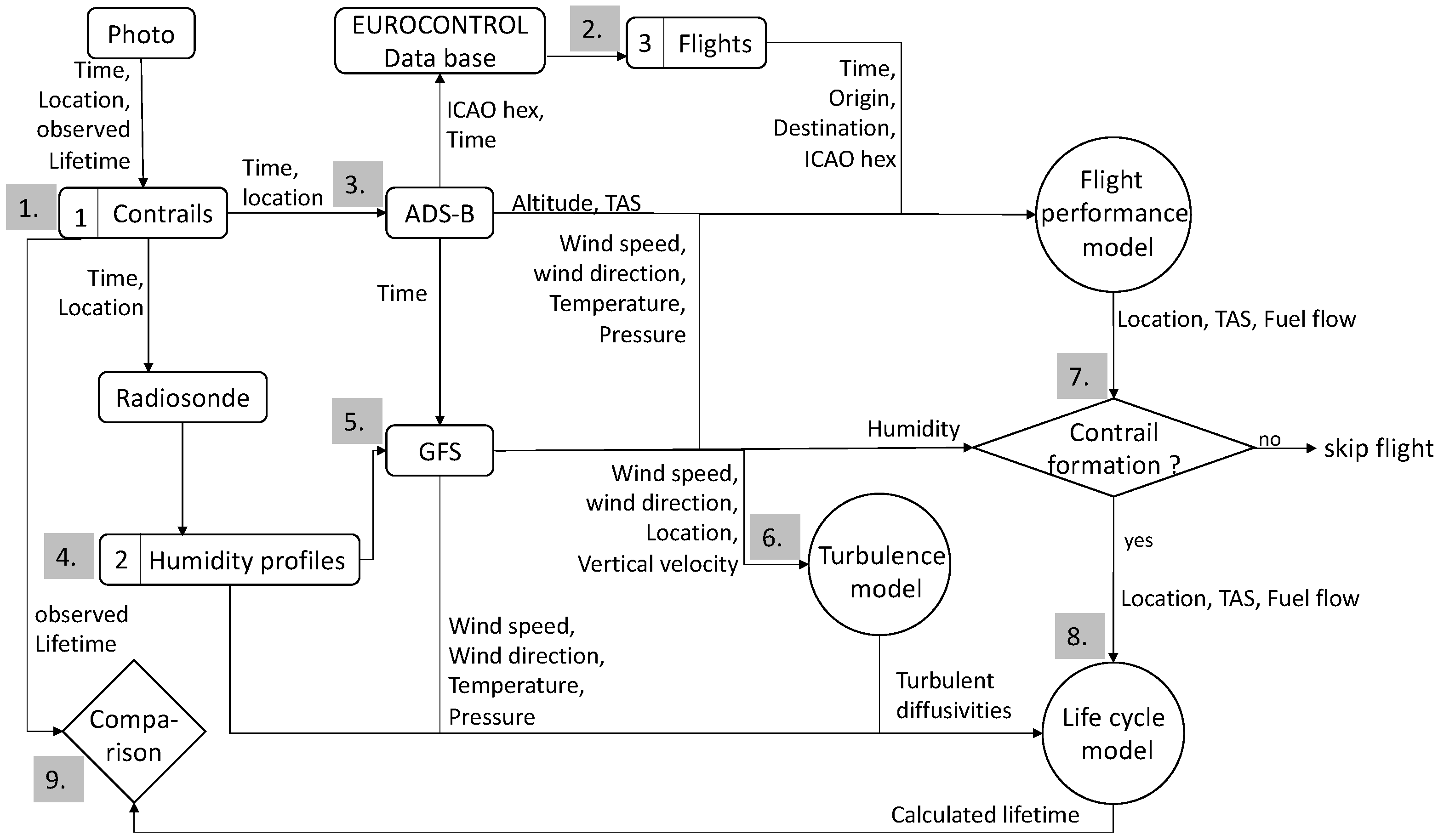
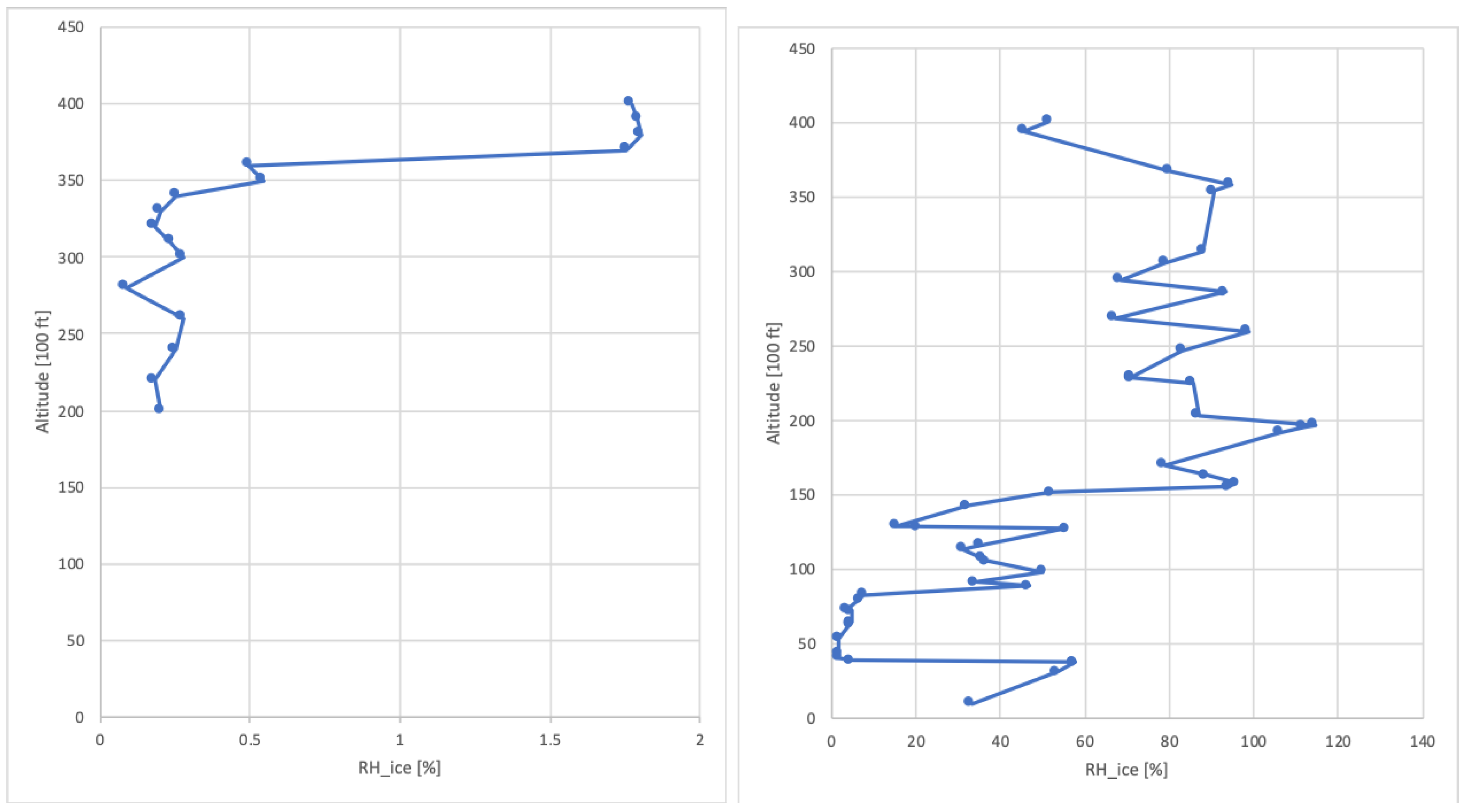
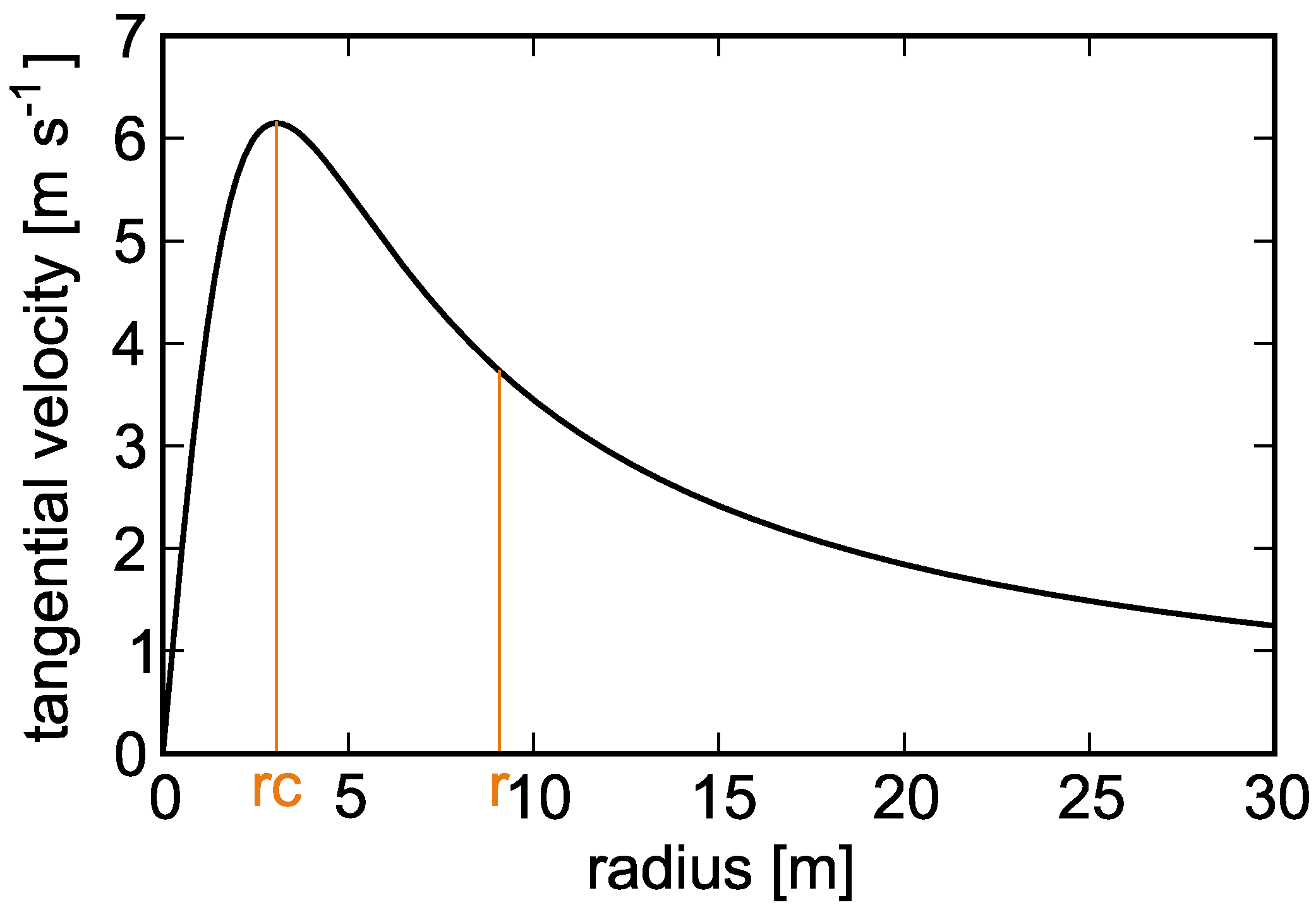

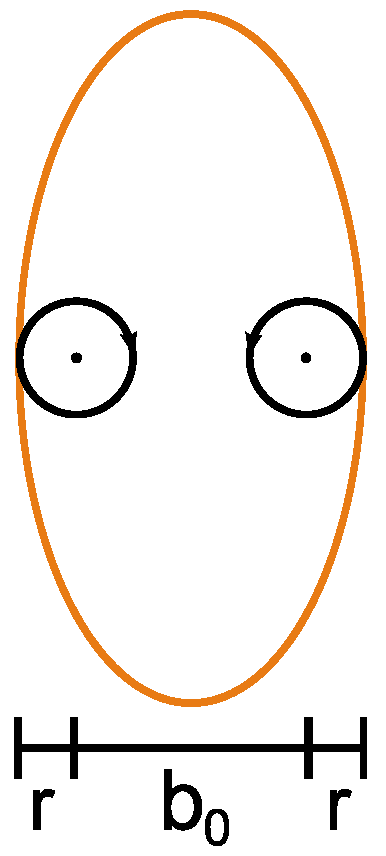

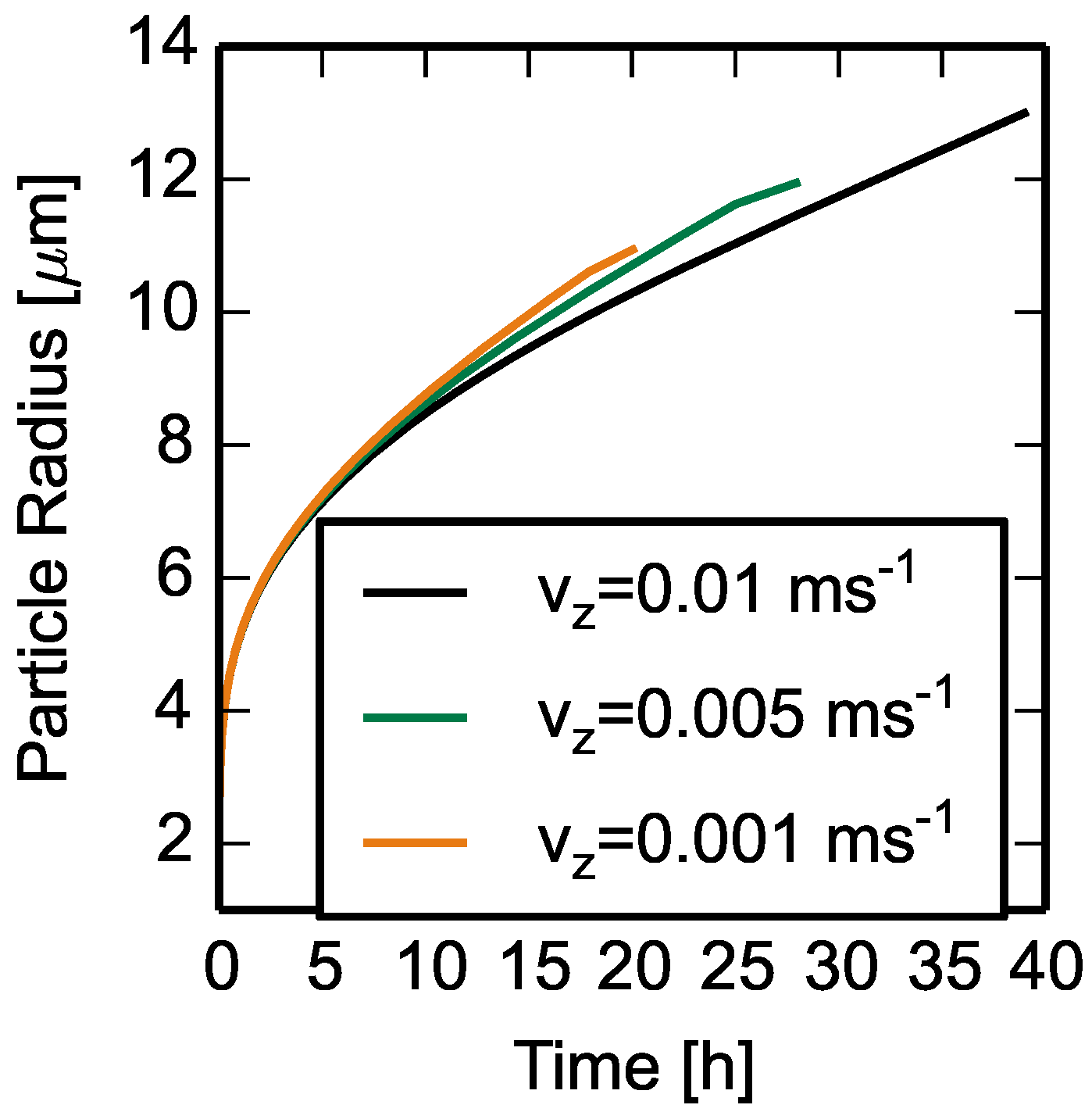


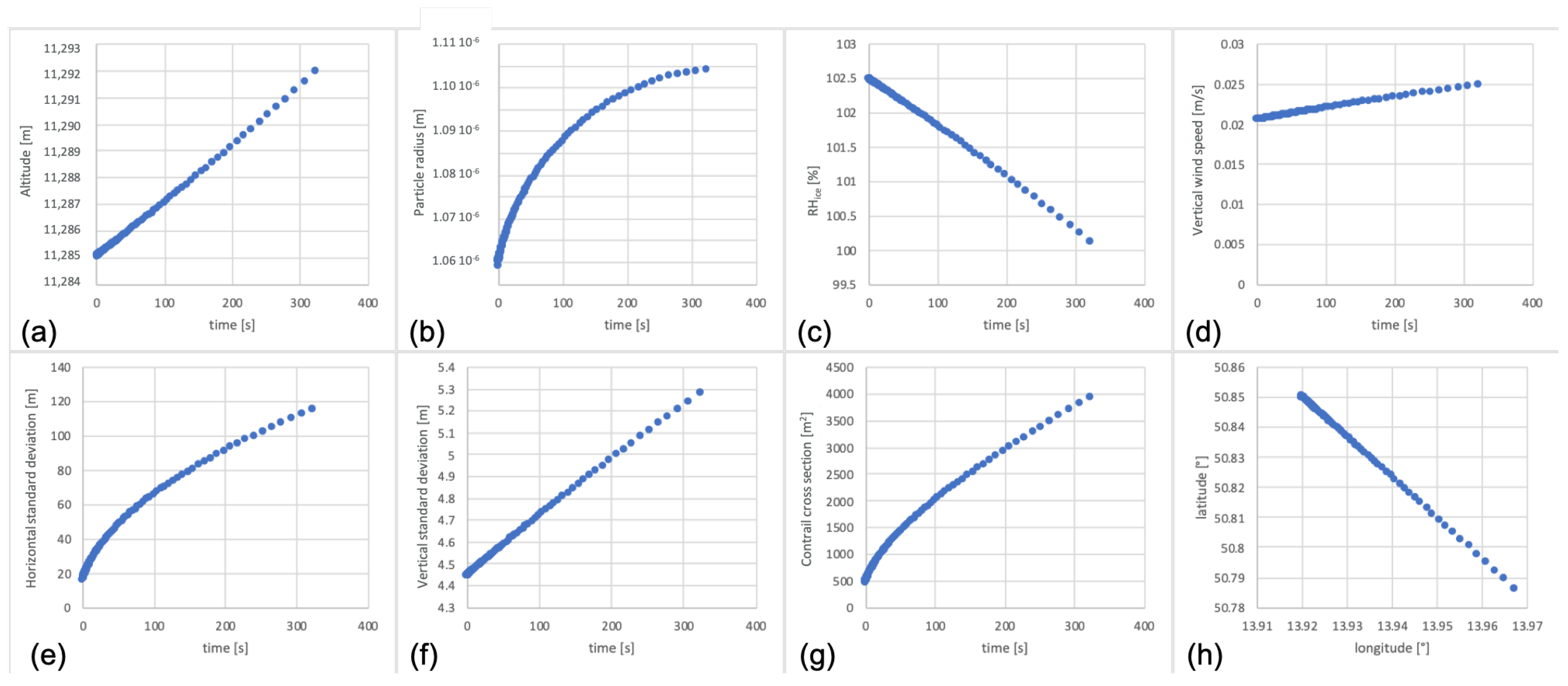
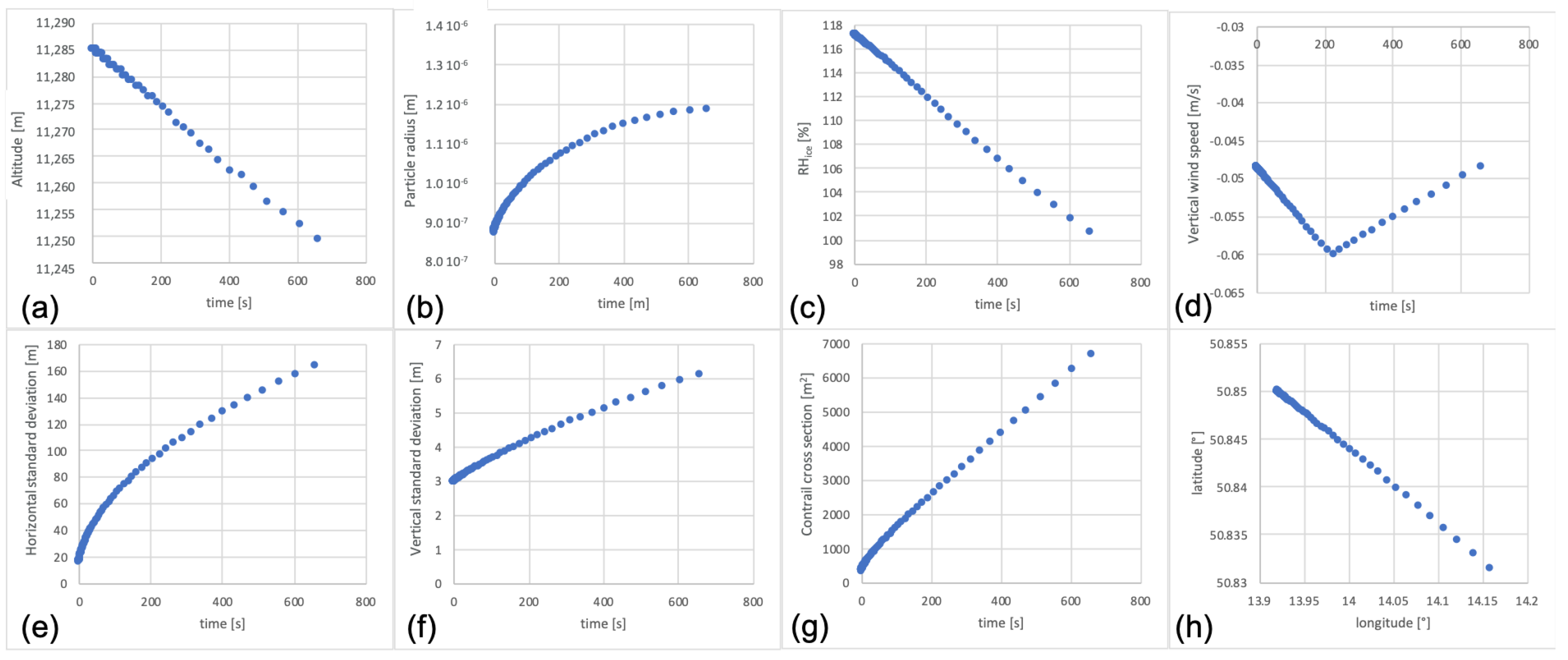
| Eddy Dissipation Rate | Horizontal Diffusivity |
|---|---|
| [ms] | [ms] |
| ICAO | Altitude | Depart. | Dest. | Obs. | Calc. | ||
|---|---|---|---|---|---|---|---|
| Hex | [ft] | [kg/s] | [m/s] | Lifetime | Lifetime | ||
| 440176 | 37,000 | LHBP | EHAM | 0.588 | 227.05 | 00:05:43 | 00:05:53 |
| 40756A | 37,000 | LOWW | EGPH | 0.592 | 226.95 | 00:10:25 | 00:10:48 |
| 471F7E | 37,000 | EGGW | LRCL | 0.590 | 229.87 | 00:11:52 | 00:11:27 |
| 4B9902 | 36,975 | EGCN | LTAI | 0.586 | 228.27 | 00:05:55 | 00:05:03 |
| 406674 | 35,000 | LOWW | EGLL | 0.676 | 235.05 | 00:05:05 | 00:05:14 |
| 4BB843 | 39,000 | EHAM | LTFJ | 0.580 | 227.69 | 00:05:13 | 00:05:13 |
| 40097C | 36,975 | EGLL | LOWW | 0.581 | 226.33 | 00:10:29 | 00:09:38 |
| 471F5D | 37,025 | EHEH | LYBE | 0.604 | 230.45 | 00:12:19 | 00:10:59 |
| 3C097B | 28,450 | EDDP | LTAI | 0.888 | 212.96 | 00:13:46 | 00:12:52 |
| 45CABA | 34,975 | EKBI | LGPZ | 0.551 | 229.42 | 00:10:17 | 00:09:59 |
| 40756A | 37,000 | EGCC | LCPH | 0.584 | 227.36 | 00:05:42 | 00:05:23 |
Disclaimer/Publisher’s Note: The statements, opinions and data contained in all publications are solely those of the individual author(s) and contributor(s) and not of MDPI and/or the editor(s). MDPI and/or the editor(s) disclaim responsibility for any injury to people or property resulting from any ideas, methods, instructions or products referred to in the content. |
© 2023 by the authors. Licensee MDPI, Basel, Switzerland. This article is an open access article distributed under the terms and conditions of the Creative Commons Attribution (CC BY) license (https://creativecommons.org/licenses/by/4.0/).
Share and Cite
Rosenow, J.; Hospodka, J.; Lán, S.; Fricke, H. Validation of a Contrail Life-Cycle Model in Central Europe. Sustainability 2023, 15, 8669. https://doi.org/10.3390/su15118669
Rosenow J, Hospodka J, Lán S, Fricke H. Validation of a Contrail Life-Cycle Model in Central Europe. Sustainability. 2023; 15(11):8669. https://doi.org/10.3390/su15118669
Chicago/Turabian StyleRosenow, Judith, Jakub Hospodka, Sébastian Lán, and Hartmut Fricke. 2023. "Validation of a Contrail Life-Cycle Model in Central Europe" Sustainability 15, no. 11: 8669. https://doi.org/10.3390/su15118669








